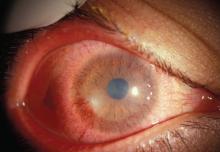User login
The FP recognized neovascularization growing onto both corneas. He had heard that this could occur with rosacea, but had never seen anything like it before. The FP called an ophthalmology colleague, who agreed to see the patient the next day.
Weeks later, the FP got a letter from the ophthalmologist thanking him for the referral and confirming that this was a severe type of ocular rosacea. It was so advanced that the patient was going to need a corneal transplant to restore normal vision.
The ophthalmologist placed the patient on oral doxycycline 100 mg twice daily and topical ophthalmic cyclosporin to control the inflammatory process until a corneal transplant could be arranged. (Getting inflammation under control is essential before a transplant can be performed.)
Text for Photo Rounds Friday courtesy of Richard P. Usatine, MD. Photo courtesy of Paul Comeau. This case was adapted from: Chumley H, Usatine R. Differential diagnosis of the red eye. In: Usatine R, Smith M, Mayeaux EJ, et al, eds. Color Atlas of Family Medicine. 2nd ed. New York, NY: McGraw-Hill; 2013:163-168.
To learn more about the Color Atlas of Family Medicine, see: http://www.amazon.com/Color-Family-Medicine-Richard-Usatine/dp/0071769641/ref=dp_ob_title_bk
You can now get the second edition of the Color Atlas of Family Medicine as an app for mobile devices by clicking this link: http://usatinemedia.com/
The FP recognized neovascularization growing onto both corneas. He had heard that this could occur with rosacea, but had never seen anything like it before. The FP called an ophthalmology colleague, who agreed to see the patient the next day.
Weeks later, the FP got a letter from the ophthalmologist thanking him for the referral and confirming that this was a severe type of ocular rosacea. It was so advanced that the patient was going to need a corneal transplant to restore normal vision.
The ophthalmologist placed the patient on oral doxycycline 100 mg twice daily and topical ophthalmic cyclosporin to control the inflammatory process until a corneal transplant could be arranged. (Getting inflammation under control is essential before a transplant can be performed.)
Text for Photo Rounds Friday courtesy of Richard P. Usatine, MD. Photo courtesy of Paul Comeau. This case was adapted from: Chumley H, Usatine R. Differential diagnosis of the red eye. In: Usatine R, Smith M, Mayeaux EJ, et al, eds. Color Atlas of Family Medicine. 2nd ed. New York, NY: McGraw-Hill; 2013:163-168.
To learn more about the Color Atlas of Family Medicine, see: http://www.amazon.com/Color-Family-Medicine-Richard-Usatine/dp/0071769641/ref=dp_ob_title_bk
You can now get the second edition of the Color Atlas of Family Medicine as an app for mobile devices by clicking this link: http://usatinemedia.com/
The FP recognized neovascularization growing onto both corneas. He had heard that this could occur with rosacea, but had never seen anything like it before. The FP called an ophthalmology colleague, who agreed to see the patient the next day.
Weeks later, the FP got a letter from the ophthalmologist thanking him for the referral and confirming that this was a severe type of ocular rosacea. It was so advanced that the patient was going to need a corneal transplant to restore normal vision.
The ophthalmologist placed the patient on oral doxycycline 100 mg twice daily and topical ophthalmic cyclosporin to control the inflammatory process until a corneal transplant could be arranged. (Getting inflammation under control is essential before a transplant can be performed.)
Text for Photo Rounds Friday courtesy of Richard P. Usatine, MD. Photo courtesy of Paul Comeau. This case was adapted from: Chumley H, Usatine R. Differential diagnosis of the red eye. In: Usatine R, Smith M, Mayeaux EJ, et al, eds. Color Atlas of Family Medicine. 2nd ed. New York, NY: McGraw-Hill; 2013:163-168.
To learn more about the Color Atlas of Family Medicine, see: http://www.amazon.com/Color-Family-Medicine-Richard-Usatine/dp/0071769641/ref=dp_ob_title_bk
You can now get the second edition of the Color Atlas of Family Medicine as an app for mobile devices by clicking this link: http://usatinemedia.com/

